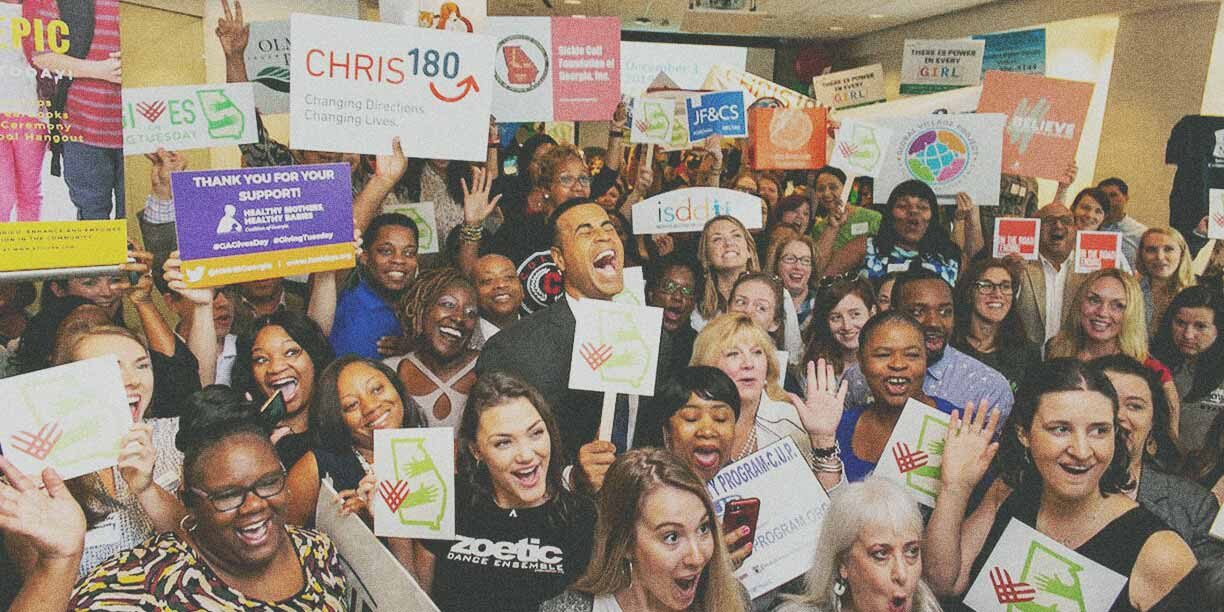Volunteer Training: Tips and Best Practices to Align Your Team

Request a Demo
Learn how top nonprofits use Classy to power their fundraising.
Volunteer training is a critical part of running successful nonprofit events, but other pressing initiatives often push it to the back seat. Vital to the sustainability of the social sector, volunteers must have the necessary training and expertise to help to the best of their abilities.
For example, volunteers may assist with your 5K charity run, provide weekly administrative support to staff, or interact directly with beneficiaries. They help balance the many moving parts of organizations’ various fundraising initiatives.
Bottom line: Volunteers help your nonprofit organization do more than it could alone.
But like any team member, they need onboarding, training tools, and support to enjoy their volunteer time and help your nonprofit make an impact. When you educate new volunteers about your organization and prepare them for their duties, you can ensure they have a positive experience and represent your nonprofit well.
Below, we’ll walk you through tips and best practices to get your volunteer training right from the get-go. This ultimate guide to volunteer training will help you turn volunteer learners into passionate leaders.
What Is Volunteer Training?
Volunteer training equips your volunteers with the knowledge, skills, and confidence they need to effectively contribute to your nonprofit organization. It’s about preparing them to complete tasks and become ambassadors of your mission.
A well-planned volunteer training program lays the foundation for success. It’s an educational journey that begins with introducing volunteers to your organization’s culture and values and their specific roles.
After that, your volunteer training will vary depending on the roles and responsibilities involved. It can range from simple tasks, like setting up event spaces, to more complex duties, like managing donor databases or leading community outreach programs. The key is tailoring the training to meet your organization’s needs and your volunteers’ skills.
Training serves a dual purpose. For the organization, it’s about ensuring volunteers are effective and efficient. But for volunteers, it’s about feeling valued and empowered, knowing they have the support and knowledge necessary to make a meaningful contribution.
Effective volunteer training typically includes:
- Orientation: Introduce volunteers to your organization, its mission, and its impact.
- Role-specific training: Provide detailed instructions and practice for volunteers’ specific tasks.
- Soft-skills development: Enhance communication, teamwork, and problem-solving skills.
- Safety and compliance: Ensure volunteers understand safety protocols and legal requirements.
- Ongoing education: Provide continuous learning opportunities to help volunteers grow with your organization.
Well-trained volunteers are more than helping hands—they’re informed advocates for your cause. They bring enthusiasm, commitment, and a deeper understanding of your nonprofit’s work, which translates into more effective engagement with the community and donors.
Why Volunteer Training Matters
While onboarding gives volunteers an overall understanding of your mission and work, they need to know how to complete the specific tasks they’ll perform. At orientation or on their first day, show volunteers what it’ll look like to execute their roles and introduce them to the tools they’ll use.
Remember, even if something seems straightforward to you, it may be new to them. It’s better to train volunteers initially and save yourself time later on.
Essential Steps to Volunteer Training
From the moment you begin volunteer recruitment, it’s critical to start thinking about volunteer retention. Each step you take in your new volunteer training and onboarding process helps volunteers feel welcomed and confident in their responsibilities.
1. Onboard Volunteers to Your Mission and Vision
Training opportunities should always start with showing how volunteer work relates to your mission. This ensures all volunteers know your vision, operations, and strategic plan. Plus, when you explain what volunteers help you achieve, you make their service more satisfying. Volunteers who gain a sense of accomplishment from their work are more likely to help again.
That’s why new volunteers should receive an onboarding orientation, particularly if their role requires external conversations and donor interactions. Your orientation should address:
- Organization’s mission
- Primary programs
- Case studies demonstrating impact
- Volunteer opportunities
- Basic safety instructions and rules
- Volunteer hours documentation procedures
- Frequently asked questions
With this information, volunteers will know what you seek to accomplish, how you plan to make an impact, and what they can do to help. If you need to onboard several volunteers, prepare a short webinar or volunteer manual to deliver these details at scale.
Nonprofits frequently recruiting volunteers can set up a monthly orientation meeting or online training to bring new supporters up to speed.
2. Build Effective Volunteer Training Courses by Role
While initial onboarding helps volunteers understand your mission and work, task-specific training is where they’ll develop the confidence required to deliver on their responsibilities effectively.
At orientation or on their first day, assign mentors to your volunteers. This one-on-one support ensures all volunteers feel supported. But if your volunteer base isn’t large enough to conduct one-on-one mentorship, adopt a one-to-many approach as a great alternative.
Training is also easier to manage when volunteer roles and learning objectives are clearly defined. This allows you to provide the proper training materials. For example, volunteers helping with your social media will need to know how to log into your accounts and where to find approved photos for posting.
Also, ensure your volunteers know their supervisor. They should always have access to a staff member to answer real-time questions and offer solutions.
3. Connect New Volunteers’ Skills to the Right Opportunities
On top of volunteers being a great resource for delegating simple tasks, they also bring unique experiences and skills to your organization. Use sites like LinkedIn, Catchafire, or Idealist to list volunteer positions and recruit people with specialized skills, such as web design or grant writing.
When assigning special projects, incorporate volunteers’ past experiences with the skills required for the current project. Bring volunteers up to speed on your brand-specific elements so they can apply their skills to best reflect your organization. For example, if a writer offers to help your marketing department write blogs, they must understand your voice and tone.
After working with an engaged volunteer for some time, you may even let them take charge of a project or initiative. They might be interested in a particular area or have an idea to improve operations.
4. Recognize Your Volunteers’ Contributions
After you’ve onboarded volunteers to your mission, walked them through their specific responsibilities, and matched them to the best opportunities, there’s one more key step to ensuring success: show your appreciation.
Take your volunteer engagement strategy to the next level by finding creative ways to recognize the time and care your volunteers provide your nonprofit. You could:
- Give them a shoutout on a local podcast or radio station.
- Highlight them on social media throughout National Volunteer Month in April.
- Host a special event on April 20 for Volunteer Recognition Day.
- Send them a birthday or thank-you note to show you care.
- Include them in your nonprofit annual report.
Use volunteer management software to keep track of your volunteers’ anniversaries and other facts about them to fuel ongoing stewardship.
Best Practices for Effective Volunteer Training
Creating a successful volunteer training program involves more than conveying information—it’s about resonating with volunteers and preparing them for their roles.
Avoid just going through the motions, talking at your volunteers instead of with them. You want each person to learn and internalize the principles, which will involve more planning and creativity on your end.
Here are some best practices to ensure your volunteer training is effective and impactful:
- Define clear learning objectives: Determine what you want volunteers to learn before designing your training program. That means setting specific, measurable learning objectives that align with their roles and responsibilities. This clarity helps in creating focused and relevant training content.
- Use a mix of training methods: Use various training methods to cater to diverse learning styles. This can include hands-on training, interactive workshops, video tutorials, and written materials.
- Incorporate real-world scenarios: Use real-life examples and scenarios in your training. This approach helps volunteers understand how their roles impact your organization and community. Role-playing exercises can also help prepare volunteers for situations they might encounter.
- Foster an interactive environment: Encourage questions, discussions, and interactions among volunteers during training sessions. An interactive environment makes training more engaging and helps reinforce learning through peer discussions and collaborative problem-solving.
- Provide ongoing support and resources: Offer ongoing support and resources to volunteers. This can include refresher courses, access to online resources, and regular updates on any changes in procedures or policies.
- Keep training sessions short: Respect your volunteers’ time by keeping training sessions concise and to the point. Group complex information into small, manageable segments.
- Leverage experienced volunteers: Utilize experienced volunteers as trainers or mentors. They can share valuable insights and practical tips based on their real-world experiences. Peer-led training can also foster a sense of community and belonging among volunteers.
- Evaluate and revise training programs regularly: Assess the effectiveness of your training programs by gathering feedback from volunteers and making the necessary adjustments.
How to Prepare Volunteers for Event Support
Events require a lot of volunteer support. Below, we’ll cover the steps required to properly prepare your volunteers for the big day and show you ways to apply each step.
Ensure Volunteers Are Well-Versed in Your Work
Volunteers are representatives of your nonprofit brand, so ensure they know how to talk about your organization with authority during an event. No matter their skill level, all volunteers will require a refresher before speaking to guests. Make sure each can explain:
- Your mission statement
- Your nonprofit’s “why”
- Your event’s purpose
- Your intended use for event donations
Document these answers and email them to volunteers to reference before the event. In your message, group these answers into a one- or two-sentence tagline, followed by a more detailed description. This way, when a guest asks about your organization, volunteers have a concise, on-brand answer with an in-depth explanation for longer conversations.
Run through the Event Schedule and Goals
Reminding volunteers they’re a critical part of your team is always a good idea. Facilitate this by ensuring they’re clear on your event’s goals. Share details with them, such as:
- How the event will impact your mission
- How many new donors you hope to acquire
- How you plan to engage with major donors
- How you plan to foster ongoing community
- Why you’ve chosen these goals for this event
When volunteers feel like valued members of your team, they’re more likely to adopt your goals. Simply put, sharing this information makes them feel included in your mission.
You should also give a run-through of the event schedule and email it to your volunteers for reference. In it, inform them when to arrive, where to check in, and when the event ends. Also, let them know if there’s a dress code.
Prep Volunteers for Event FAQs
Your volunteers will likely receive logistical questions at the event. Prepare them to respond to any scenario by covering possible inquiries about parking, restrooms, the check-in process, food allergies, seating, and the venue.
Also, train volunteers on how to handle difficult or unexpected situations. For example, what happens if a preregistered guest’s name doesn’t appear on the guest list? If you’re hosting a wine-tasting event, how should volunteers respond when a guest brings a child? Everyone benefits when your staff and volunteers feel ready and capable.
Again, ensure your volunteers know who to contact for other questions, concerns, or emergencies.
Thank Volunteers After the Event
Saying thank you goes a long way. After your event, send your volunteers a letter or host a special appreciation gathering to express your gratitude. Let them know how well the event did toward meeting your goals and remind them that they played a critical role in that success. This will help build long-lasting relationships and increase their likelihood of volunteering again.
To demonstrate that you value their opinions, you can also send them a follow-up survey to find out what they enjoyed, whether they felt prepared to do their jobs, and how you can improve their experience in the future.
Build Your Volunteer Training Program
The journey to building a more effective volunteer training program begins with a single step. You don’t have to overhaul your entire approach overnight. Start by incorporating some key steps and best practices outlined in this article. Even small changes can significantly affect how your volunteers engage with your mission and perform their roles.
Remember, creating an impactful volunteer training program is an ongoing process. It’s about commitment to continuous improvement and adaptation. As your organization evolves, so should your approach to training. Always stay open to feedback, be willing to make adjustments, and look for ways to enhance the volunteer experience.
Begin with small, manageable steps. Maybe it’s updating your training materials, introducing a new interactive training session, or spending more time getting to know your volunteers’ skills and interests. Each step you take is a move toward a more robust and effective training program.
Copy Editor: Ayanna Julien

The Fundraising Event Experience Report
Subscribe to the Classy Blog
Get the latest fundraising tips, trends, and ideas in your inbox.
Thank you for subscribing
You signed up for emails from Classy
Request a Demo
Learn how top nonprofits use Classy to power their fundraising.
 Explore Classy.org
Explore Classy.org 

